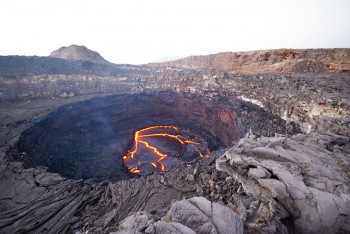THE EXHIBITION
BETWEEN SALT AND LAVA: THE AFAR DEPRESSION
 The Afar Depression lies within the Rift Valley structures of north-east Ethiopia, extending into south-east Eritrea. Here a complex pattern of fault lines, consequence of the plate tectonics involving movements of the African and Arabian shields, have produced an extremely unstable area characterized by a very arid environment with large zones consisting only of solidified lava, sand and stone. The landscape is dominated by numerous volcanic features where the magma lies close to the surface; the Awash is the only permanent river. Never far from sea-level and below, the area has very high daytime temperatures (in excess of 50°C) while at night it falls well below zero.
The Afar Depression lies within the Rift Valley structures of north-east Ethiopia, extending into south-east Eritrea. Here a complex pattern of fault lines, consequence of the plate tectonics involving movements of the African and Arabian shields, have produced an extremely unstable area characterized by a very arid environment with large zones consisting only of solidified lava, sand and stone. The landscape is dominated by numerous volcanic features where the magma lies close to the surface; the Awash is the only permanent river. Never far from sea-level and below, the area has very high daytime temperatures (in excess of 50°C) while at night it falls well below zero.
The depression has long been a source of common salt; it is there that the salt bars (amolè), used as currency throughout Ethiopia starting with Aksumite times, were produced and carried on the highlands. Alongside salt, the Afar Depression, due to its geology, is a source of several other commodities such as gypsum, potash and sulphur.
Within this fascinating but extremely harsh landscape, live the Afar, Cushitic speaking people, who move throughout this deserted land with their livestock and light, easy-to-carry traditional houses. Their name is not mentioned in any of the ancient sources and has no explanation in the Afar language. The Afar are predominantly pastoralists and live traditionally on milk and meat; durrah is bartered in markets in exchange for skins and livestock. They divide their territory into major political and territorial units called badó (generally translated as “sultanate”), whose chiefs bear various titles. Each badó is, in turn, divided into dintó, in which each tribe (or patrilineal clan) has its definite territory. Traditional genealogies transmitted orally by the elders inform us about how this tribal distribution changed through time.
Afar traditional literature is mostly oral, apart from religious poetry and historical chronicles written in Afar (the Afar language) mixed with Arabic. As in other Cushitic cultures, poetry (gad) is sung in public, narratives (missíla) are told in private. The oral traditional genres are divided into religious and profane and masculine and feminine chants, and include, as an example, “Praise of the Prophet”, “Praise of the Saints”, “Praise of the oryx accompanied by the flute”, “Praise of the she-camel”, “Evening chants”, “Vaticination chants”, and ”Warrior’s initiation chants”.
Extremely proud of their cultural identity, the Afar people are a good example of the ability of human groups to adapt to the most inhospitable environment.























